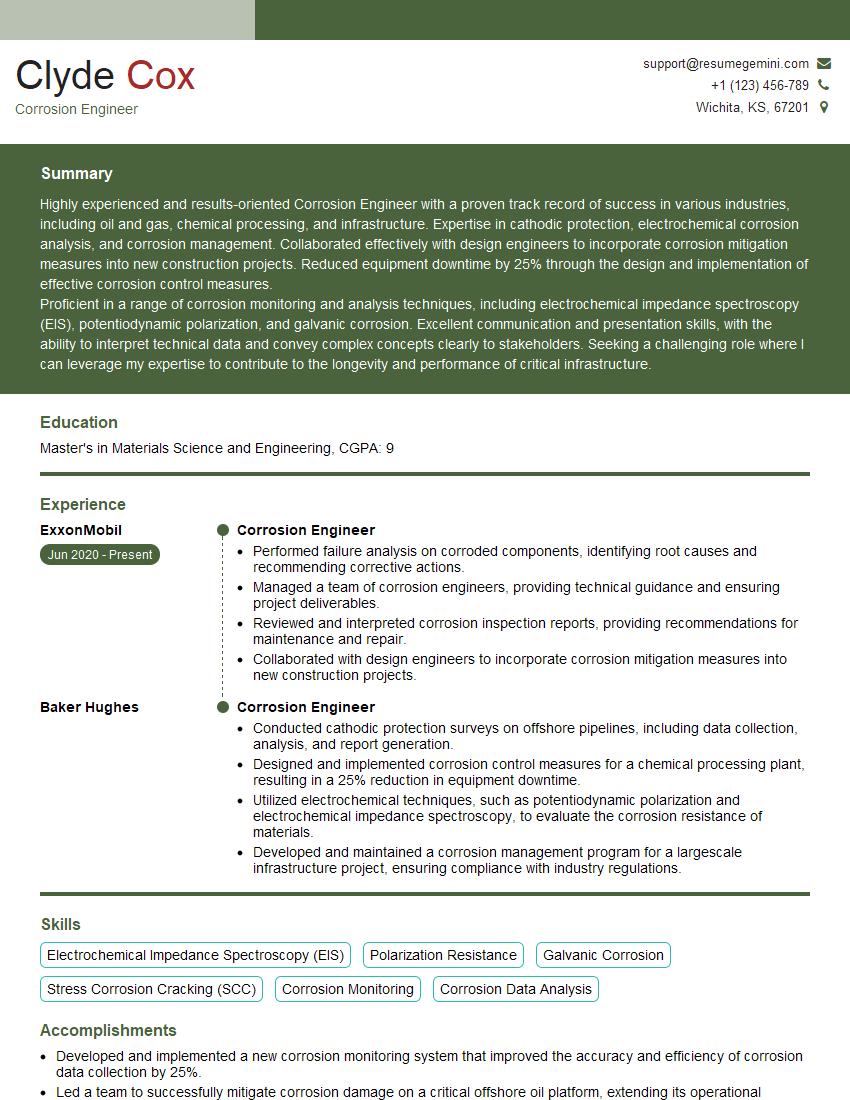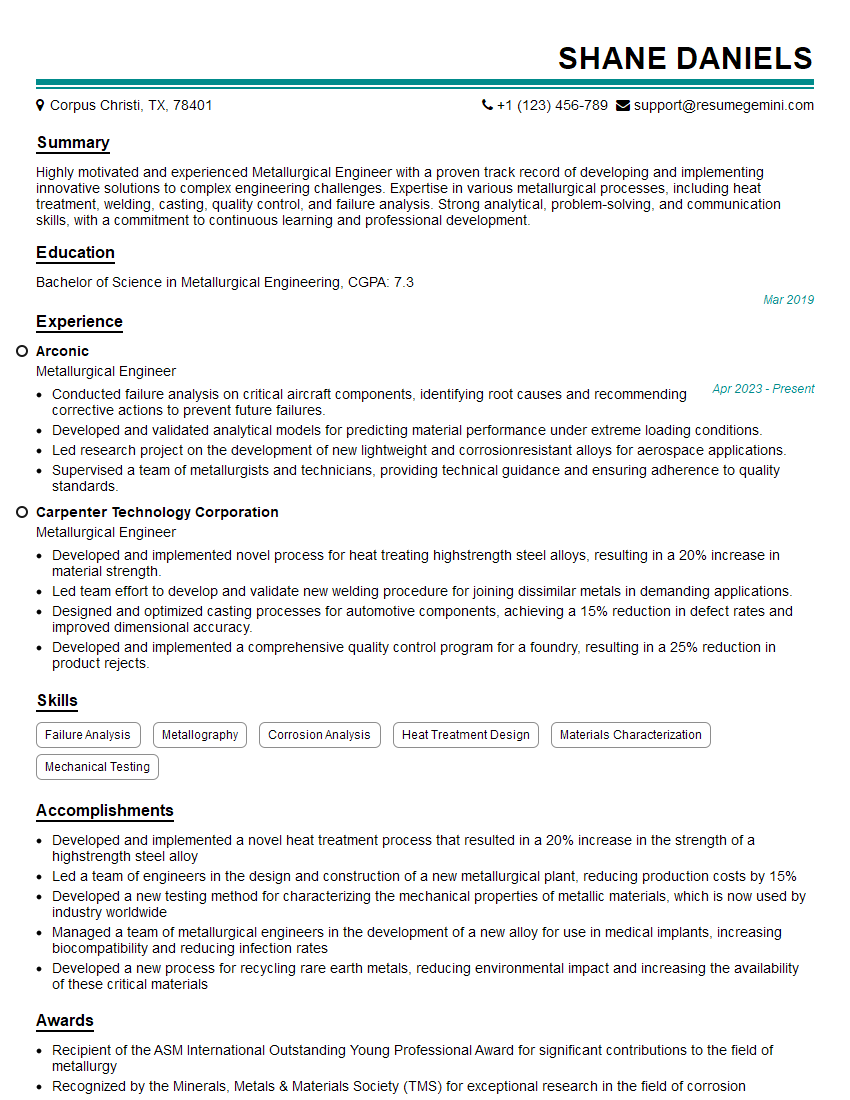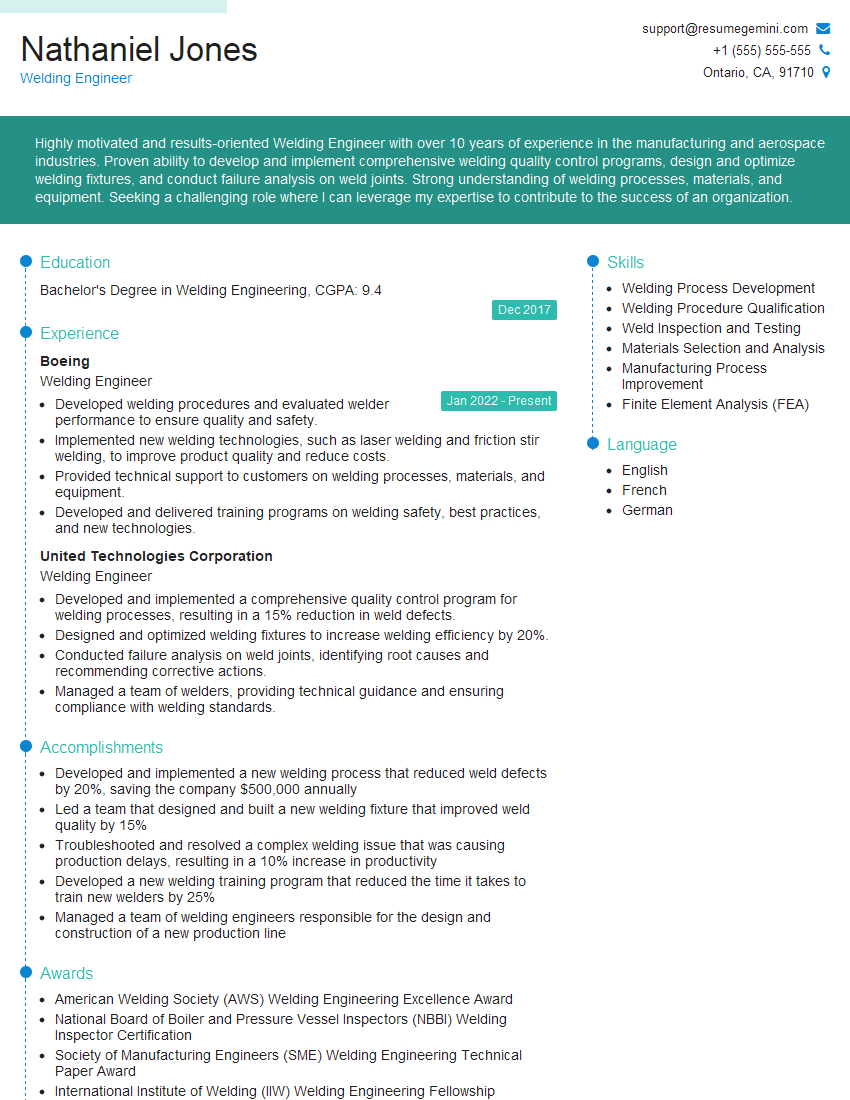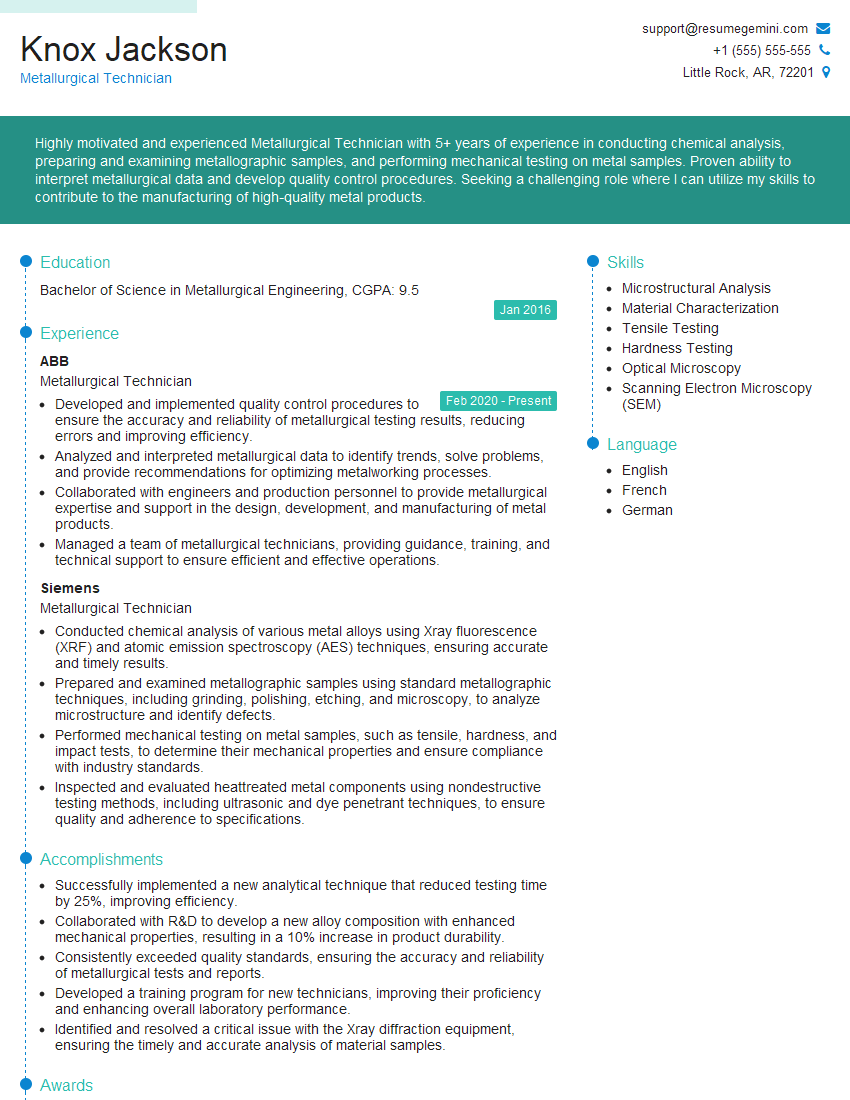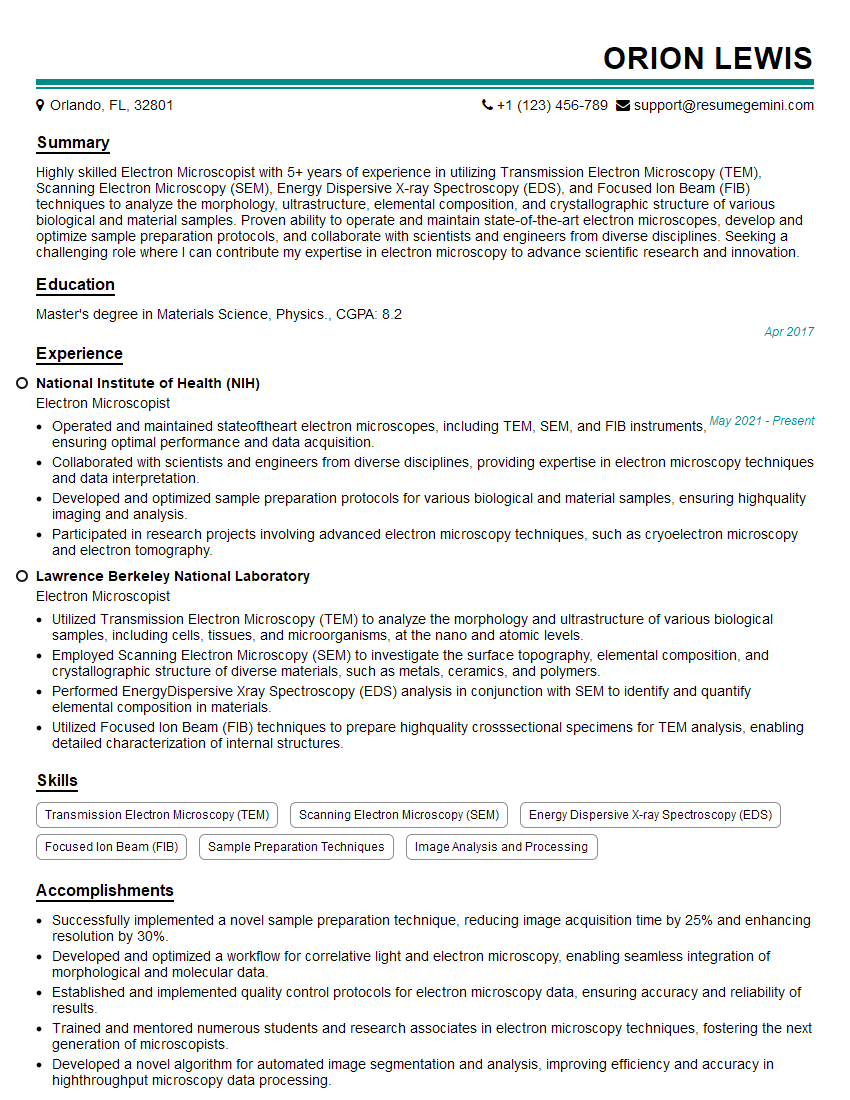Interviews are more than just a Q&A session—they’re a chance to prove your worth. This blog dives into essential Cementite Formation interview questions and expert tips to help you align your answers with what hiring managers are looking for. Start preparing to shine!
Questions Asked in Cementite Formation Interview
Q 1. Explain the process of cementite formation in steel.
Cementite formation in steel is a crucial process driven by the solubility of carbon in iron. At high temperatures, iron can dissolve a significant amount of carbon. However, as the steel cools, the solubility of carbon in iron decreases. This excess carbon, exceeding the solubility limit, precipitates out of the austenite (a high-temperature face-centered cubic phase of iron) forming iron carbide, also known as cementite (Fe3C).
Think of it like dissolving sugar in water. At high temperatures (hot water), you can dissolve a lot of sugar. As the water cools, the solubility decreases, and the excess sugar crystallizes out of the solution. Similarly, the excess carbon in cooling steel precipitates as cementite.
Q 2. Describe the role of carbon content in cementite precipitation.
The carbon content is the primary driver of cementite precipitation. The higher the carbon content in the steel, the more cementite will form. This is because a greater amount of carbon will exceed the solubility limit as the steel cools. For example, a high-carbon steel (e.g., >0.8% carbon) will have a significantly higher volume fraction of cementite than a low-carbon steel (e.g., <0.02% carbon). The amount of cementite directly impacts the final microstructure and consequently the mechanical properties.
Q 3. How does cooling rate affect cementite morphology?
The cooling rate profoundly affects the morphology (shape and size) of cementite. Slow cooling allows sufficient time for large, well-defined cementite particles to form. These are often seen as coarse, plate-like structures within the microstructure. In contrast, rapid cooling leads to the formation of finer, dispersed cementite particles. This is because the atoms have less time to diffuse and organize themselves into larger structures. For instance, quenching a high-carbon steel results in a very fine dispersion of cementite, whereas air cooling produces a coarser structure.
Imagine sculpting clay. Slow cooling is like having ample time to carefully shape a complex design, while fast cooling is like quickly pressing the clay into a simple form. The final product reflects the available time.
Q 4. What are the different forms of cementite and their properties?
Cementite exists in various forms, depending on the processing conditions. The most common forms include:
- Lamellar cementite: Found in pearlite, this form appears as alternating layers of cementite and ferrite (a body-centered cubic phase of iron). It’s relatively hard and brittle.
- Massive cementite: This is a large, continuous network of cementite typically observed in hypereutectoid steels (those with more than 0.8% carbon) that forms during slow cooling.
- Network cementite: A cementite network at the grain boundaries that forms from rapid cooling. It’s highly brittle.
- Fine dispersed cementite: Found in martensite and bainite microstructures, these are tiny, dispersed cementite particles providing high strength.
The properties vary depending on the form. Lamellar cementite offers a balance of strength and ductility, while massive and network cementite contribute to brittleness. Fine dispersed cementite enhances strength and wear resistance.
Q 5. Explain the relationship between cementite and pearlite.
Pearlite is a eutectoid microstructure composed of alternating layers of ferrite and cementite. It forms at the eutectoid composition (approximately 0.8% carbon) upon slow cooling from the austenite phase. The cementite within pearlite is the lamellar type. The spacing and volume fraction of the cementite lamellae depend on the cooling rate. Essentially, pearlite represents a specific arrangement of cementite and ferrite, defining a significant portion of the microstructure in many steels.
Q 6. How does cementite formation influence the mechanical properties of steel?
Cementite formation significantly impacts the mechanical properties of steel. Because cementite is very hard (approximately 600-700 Brinell) and brittle, its presence increases the steel’s hardness and strength, especially when it’s finely dispersed. However, it also reduces ductility and toughness, making the steel more susceptible to fracture. The size, shape, and distribution of cementite are critical factors. Fine, uniformly dispersed cementite enhances strength without significantly reducing ductility; in contrast, coarse or clustered cementite leads to brittleness.
Q 7. Discuss the role of cementite in the heat treatment of steel.
Heat treatment processes, such as annealing, normalizing, and quenching, manipulate cementite to tailor the mechanical properties of steel. Annealing promotes the formation of coarse cementite, leading to improved machinability. Normalizing produces a finer cementite distribution, enhancing strength. Quenching transforms austenite into martensite (a very hard, carbon-rich phase) with finely dispersed cementite, resulting in extremely high hardness. The control of cementite precipitation through heat treatment is fundamental to achieving the desired properties in steel for various applications.
Q 8. Explain the use of TTT diagrams in predicting cementite formation.
TTT (Time-Temperature-Transformation) diagrams are essential tools for predicting the formation of cementite (Fe3C) in steels. These diagrams illustrate the transformation kinetics of austenite, the high-temperature phase of iron, into various microconstituents, including pearlite (a layered structure of ferrite and cementite) and bainite (a fine needle-like structure containing cementite). By knowing the cooling rate of the steel, you can locate that cooling path on the TTT diagram and determine the resulting microstructure. The diagram shows the time required for the transformation to occur at a specific temperature. For example, a slow cooling rate will allow sufficient time for the formation of coarse pearlite which contains relatively large cementite lamellae. In contrast, rapid cooling will result in martensite, a metastable phase that doesn’t contain cementite at all, or a fine pearlite with less cementite content.
Imagine it like baking a cake: a slow cooling (long time in the oven) allows for the formation of larger crystals (large cementite lamellae), while rapid cooling (quick removal from the oven) creates a finer-grained structure (fine pearlite or even martensite).
Q 9. How can you identify cementite using microscopy techniques?
Cementite identification relies heavily on microscopy techniques, primarily optical microscopy and transmission electron microscopy (TEM). In optical microscopy, cementite appears as a very hard, light gray phase in contrast to the surrounding ferrite (soft, dark gray). Its morphology varies considerably; it can appear as lamellae in pearlite, as networks around pearlite colonies, or as larger, independent particles (primary cementite). The distinct properties of cementite, such as its high reflectivity and hardness, make it easily distinguishable from other phases under polarized light. TEM provides higher resolution imaging, allowing for precise identification of its crystal structure and chemistry.
For instance, in a polished and etched steel sample, the use of a polarizing microscope enables one to easily differentiate cementite from ferrite and other constituent phases due to its significantly different light reflecting characteristics. In more advanced studies TEM, coupled with electron diffraction patterns, is critical for unambiguous identification of cementite’s unique crystallographic features.
Q 10. Describe the differences between primary and secondary cementite.
The distinction between primary and secondary cementite lies in their formation sequence during the solidification and cooling of steel. Primary cementite precipitates directly from the liquid phase during solidification, forming relatively large, irregular particles. It’s an early-stage phase and can be found in hypoeutectic cast irons, where it appears as large, distinct crystals within a ferrite matrix. Secondary cementite, conversely, forms from the solid state during cooling transformations of austenite. It precipitates along the grain boundaries of the ferrite or as lamellae within pearlite.
Think of it this way: primary cementite is like the foundational stones laid first in a building, whereas secondary cementite is like the detailed brickwork added later. The difference in formation timing influences their shape and size drastically.
Q 11. What is the chemical formula of cementite?
The chemical formula of cementite is Fe3C. It’s an iron carbide, a hard and brittle intermetallic compound.
Q 12. Explain the effect of alloying elements on cementite formation.
Alloying elements significantly influence cementite formation. Some elements, like chromium (Cr), molybdenum (Mo), tungsten (W), and vanadium (V), are strong carbide formers; they increase the amount of cementite in the steel. These elements enhance the formation of carbides and affect the type of carbide formed. Other elements, such as nickel (Ni) and manganese (Mn), can reduce cementite formation by increasing the austenite stability. The effect of an alloying element depends on its affinity for carbon and how it alters the Fe-C equilibrium diagram. For example, adding chromium to steel results in the formation of chromium carbides which are harder and more corrosion resistant compared to cementite. This profoundly alters the steel’s microstructure and properties.
Q 13. How does cementite formation affect the hardenability of steel?
Cementite formation significantly affects the hardenability of steel. Hardenability refers to the ability of a steel to harden upon quenching. The presence of cementite, especially in the form of fine pearlite, increases hardenability. Fine pearlite, which contains fine dispersed cementite particles, hinders the diffusion of carbon during cooling, resulting in a greater depth of hardening. In contrast, the presence of coarse cementite particles, or primary cementite, decreases the hardenability. The shape, size, and distribution of cementite particles all play a role in influencing hardenability. A well-distributed, fine structure of cementite promotes enhanced hardenability, whereas coarse distributions are detrimental.
Q 14. Describe the microstructure of white cast iron and its relation to cementite.
White cast iron is characterized by a microstructure primarily composed of cementite and very little or no graphite. The high carbon content of white cast iron (typically above 4.3 wt% C) promotes extensive cementite formation. The microstructure often consists of a network of cementite surrounding pearlite or martensite. The high cementite content accounts for white cast iron’s extreme hardness and brittleness; cementite is very hard and brittle, contributing directly to the material’s overall characteristics. The absence of graphite, which in other cast irons makes them grey, is responsible for its white colour.
Think of it like this: white cast iron is essentially an iron-carbon alloy where the carbon is predominantly locked up in the very hard cementite phase, making the material extremely hard but also quite brittle.
Q 15. Explain the role of cementite in wear resistance.
Cementite (Fe3C), a hard and brittle iron carbide, significantly impacts the wear resistance of steel. Its role is primarily attributed to its high hardness, which is approximately 800 Brinell. Think of it like adding tiny, incredibly hard particles to a softer metal matrix. When subjected to abrasive wear, these cementite particles resist deformation and scratching, preventing material loss. The more cementite present, generally the higher the wear resistance, although the microstructure also plays a crucial role. For example, finely dispersed cementite in a pearlitic structure provides better wear resistance than large, coarse cementite particles because the fine dispersion offers better resistance to crack propagation. This is why many wear-resistant steels, like those used in cutting tools or mining equipment, are carefully designed to incorporate a specific amount and distribution of cementite.
Imagine trying to scratch a surface sprinkled with tiny diamonds versus a smooth, soft surface. The diamonds, analogous to cementite, significantly increase resistance to scratching.
Career Expert Tips:
- Ace those interviews! Prepare effectively by reviewing the Top 50 Most Common Interview Questions on ResumeGemini.
- Navigate your job search with confidence! Explore a wide range of Career Tips on ResumeGemini. Learn about common challenges and recommendations to overcome them.
- Craft the perfect resume! Master the Art of Resume Writing with ResumeGemini’s guide. Showcase your unique qualifications and achievements effectively.
- Don’t miss out on holiday savings! Build your dream resume with ResumeGemini’s ATS optimized templates.
Q 16. How does cementite contribute to the corrosion resistance of steel?
Cementite’s contribution to corrosion resistance is more nuanced and less direct than its effect on wear resistance. While cementite itself isn’t inherently corrosion-resistant, its presence can influence the overall corrosion behavior of steel. The effect depends heavily on factors like the cementite’s morphology (shape and distribution) and the steel’s overall composition. In some cases, a fine dispersion of cementite can act as a barrier, hindering the penetration of corrosive agents. However, cementite can also act as a preferential site for corrosion initiation, particularly in aggressive environments, because cementite is anodic compared to ferrite in many corrosive environments. This can lead to localized corrosion or pitting around the cementite particles. Consequently, the corrosion resistance is not simply increased by cementite content but also heavily influenced by the microstructure and other alloying elements.
For instance, in stainless steels, the chromium-rich regions might be more resistant to corrosion than areas with significant cementite concentration. The interaction is complex and needs to be considered in the context of the entire steel’s composition and microstructure.
Q 17. Discuss the limitations of cementite in specific applications.
Cementite’s inherent brittleness is its primary limitation. While contributing to hardness and wear resistance, excessive cementite makes the steel brittle and susceptible to cracking under stress. This brittleness significantly restricts its applications where toughness and ductility are critical. For instance, in structural applications requiring impact resistance, high cementite content would be detrimental. Furthermore, the localized corrosion at cementite sites, as discussed earlier, can be a significant drawback in specific corrosive environments. Finally, the machining of high-cementite steels is challenging due to their hardness, requiring specialized tooling and techniques.
Consider a car chassis: high cementite content would make the chassis extremely hard-wearing but also prone to cracking under impact, potentially catastrophic in a collision. Therefore, a balance between hardness and toughness is crucial, limiting the amount of cementite acceptable in such applications.
Q 18. Describe the methods used to control cementite formation during manufacturing.
Controlling cementite formation involves manipulating the carbon content and cooling rate during steel manufacturing. The iron-carbon phase diagram is the roadmap for this control. Lowering the carbon content directly reduces the amount of cementite that can form. Cooling rate is equally critical. Slow cooling allows for the formation of coarse cementite, whereas rapid cooling promotes the formation of fine pearlite (a lamellar structure of ferrite and cementite), resulting in a significantly different microstructure and mechanical properties. Furthermore, alloying elements can influence cementite formation. Elements like chromium, molybdenum, and tungsten can suppress cementite formation or modify its morphology, allowing for fine-tuning of the final microstructure and properties.
Techniques like controlled cooling in a furnace, quenching, and tempering are used to achieve the desired cementite distribution. Heat treatments are specifically designed to control the transformation kinetics and, consequently, the final cementite structure.
Q 19. Explain the relationship between cementite and the iron-carbon phase diagram.
The iron-carbon phase diagram is fundamental to understanding cementite formation. The diagram shows the phases present in iron-carbon alloys at different temperatures and compositions. Cementite (Fe3C) is a stable phase at equilibrium below approximately 727°C (1341°F) for a range of carbon content. The diagram clearly delineates the regions where cementite forms – typically as part of pearlite, ledeburite, or as primary cementite depending on the carbon concentration and cooling process. The diagram is indispensable for predicting the microstructure and thus the properties of a steel based on its chemical composition and thermal history.
By analyzing the iron-carbon phase diagram, metallurgists can predict the amount and type of cementite that will form under given processing conditions, allowing for tailored material properties.
Q 20. What is the significance of the eutectoid reaction in cementite formation?
The eutectoid reaction is a crucial point on the iron-carbon phase diagram at 0.77% carbon and 727°C (1341°F). At this composition, austenite, a high-temperature phase of iron and carbon, transforms upon cooling into pearlite – a fine, lamellar microstructure consisting of alternating layers of ferrite and cementite. This eutectoid reaction is paramount because it defines the composition at which the maximum amount of pearlite (and therefore, a specific distribution of cementite) forms. Controlling the cooling rate around this eutectoid point is essential in obtaining the desired microstructure and hence the mechanical properties.
Imagine it as a recipe: the eutectoid point is the ideal ratio of ingredients (iron and carbon) to create the desired texture (pearlite) with a specific amount of cementite within that structure.
Q 21. How can you determine the amount of cementite in a steel sample?
Several methods exist for determining the amount of cementite in a steel sample. One common technique is quantitative metallography. This involves preparing a polished and etched sample, examining it under a microscope, and measuring the area fraction of cementite. Image analysis software can automate this process, providing an accurate estimation of the volume percentage of cementite. Another method is X-ray diffraction (XRD). XRD can identify phases present in a material and quantify their relative amounts based on the intensity of their diffraction peaks. Finally, chemical analysis can provide the total carbon content. While not directly indicating cementite amount, knowing the total carbon content along with the microstructure information (e.g., from metallography) helps to estimate the cementite content, accounting for carbon present in other carbides or dissolved in the ferrite phase.
The choice of method depends on the desired accuracy, availability of equipment, and the complexity of the steel’s microstructure.
Q 22. Explain the effect of grain size on cementite precipitation.
Grain size significantly impacts cementite precipitation. Think of it like this: a larger grain provides fewer nucleation sites—places where cementite crystals can initially form. Smaller grains, having a larger surface area, offer many more potential nucleation sites. This means that in a finer-grained steel, cementite will precipitate more readily and potentially form a finer dispersion of cementite particles throughout the microstructure. A coarser grain structure will typically lead to larger, less uniformly distributed cementite particles. This difference in distribution dramatically affects the final mechanical properties of the steel.
For example, consider two steels with the same carbon content: one with a coarse grain size and the other with a fine grain size. The fine-grained steel will likely exhibit a greater number of smaller cementite particles. This finer dispersion can lead to improved mechanical properties such as increased strength and toughness, compared to the coarser-grained steel which might show reduced ductility due to the presence of larger cementite particles. The size and distribution of cementite strongly influence the steel’s overall performance.
Q 23. Describe the challenges involved in modelling cementite formation.
Modeling cementite formation is challenging due to the complex interplay of several factors. First, the process is diffusion-controlled, meaning the rate of cementite formation depends on the speed at which carbon atoms diffuse through the austenite (the high-temperature phase of steel) to reach the cementite nucleation sites. Accurately predicting diffusion rates requires sophisticated computational methods and precise knowledge of the alloy’s composition and temperature.
Second, the nucleation process itself is stochastic—meaning random—and difficult to predict precisely. The number and location of nucleation sites aren’t easily determined, and the initial growth of cementite particles is sensitive to subtle changes in temperature and composition. This requires significant computational power to model accurately.
Finally, cementite morphology (shape and size) can be quite complex. Modeling the intricate shapes and growth patterns of cementite requires advanced numerical techniques and often relies on simplifying assumptions that can affect the accuracy of the results. It’s a computationally intensive process.
Q 24. Discuss the advancements in understanding cementite formation in recent years.
Recent advancements in understanding cementite formation have largely been driven by improved characterization techniques and computational modeling capabilities. Advanced microscopy techniques, such as atom probe tomography (APT), offer unprecedented resolution for visualizing cementite precipitation at the atomic level. This allows researchers to better understand the initial stages of nucleation and the subsequent growth processes with greater precision.
Furthermore, the development of more sophisticated computational models, incorporating detailed thermodynamics and kinetics, allows for more accurate predictions of cementite formation under various conditions. These models can incorporate parameters that previously were difficult to address such as the influence of alloying elements beyond carbon and the effect of different cooling rates. The increased use of machine learning approaches is also starting to help accelerate and refine these predictive capabilities.
Q 25. How does cementite formation influence the toughness of steel?
Cementite formation significantly influences the toughness of steel. A finely dispersed distribution of small cementite particles can actually enhance toughness. This is because these fine particles act as obstacles to crack propagation. The cracks need to expend more energy to navigate around these obstacles, thus improving the steel’s resistance to fracture.
However, larger cementite particles can have the opposite effect, significantly reducing toughness. Large, continuous cementite phases can act as stress concentrators, making it easier for cracks to initiate and propagate, leading to brittle fracture. This is why controlling cementite morphology is critical for designing tough steels. Think of it like adding pebbles to a smooth, unbroken surface – small pebbles are less detrimental, but large, sharp rocks will cause damage more easily.
Q 26. Describe the effect of temperature and pressure on cementite formation.
Temperature and pressure play crucial roles in cementite formation. Cementite formation is strongly temperature dependent. It typically occurs during the cooling of austenite, where below a certain critical temperature (the eutectoid temperature, approximately 727°C for a eutectoid steel), austenite becomes thermodynamically unstable and transforms into ferrite and cementite.
The cooling rate is particularly important. A slower cooling rate allows for more complete diffusion and the formation of larger, coarser cementite particles. Faster cooling rates limit diffusion and result in finer cementite dispersions. Pressure can affect the equilibrium phase diagrams of steel, influencing the thermodynamic conditions under which cementite forms. However, compared to temperature, the effect of pressure on cementite precipitation in typical steel processing is generally less significant.
Q 27. Explain the role of nucleation sites in cementite precipitation.
Nucleation sites are essential for cementite precipitation. They provide energetically favorable locations for the initial formation of cementite nuclei. These sites can be various microstructural features, such as grain boundaries, dislocations, inclusions (e.g., oxides, sulfides), and even other precipitate phases. The presence of these sites reduces the energy barrier for nucleation, making it easier for cementite to form.
The density and type of nucleation sites strongly influence the number, size, and distribution of cementite particles. For instance, a high density of grain boundaries will likely lead to more numerous and smaller cementite particles compared to a material with fewer nucleation sites. A higher density of nucleation sites generally results in a finer dispersion of cementite, which is often desirable for improving mechanical properties.
Q 28. How can you prevent unwanted cementite formation in a specific steel alloy?
Preventing unwanted cementite formation depends heavily on the specific steel alloy and the desired microstructure. Key strategies include:
- Alloying additions: Certain alloying elements can suppress cementite formation or alter its morphology. For example, elements like silicon, manganese, and molybdenum can refine the austenite grain size, promoting a finer distribution of cementite if it does form. Other elements can reduce the driving force for cementite precipitation, slowing the process.
- Controlled cooling rates: Rapid cooling (quenching) can prevent the formation of equilibrium cementite phases by suppressing the diffusion of carbon atoms. This results in a metastable microstructure such as martensite which is essentially carbon supersaturated ferrite.
- Thermomechanical processing: Combining heat treatments with controlled deformation can manipulate the microstructure and affect cementite precipitation. For instance, controlled rolling can refine the grain size, creating many nucleation sites and promoting a finer distribution of cementite.
- Cleanliness of the steel: Minimizing the presence of inclusions in the steel can reduce the number of heterogeneous nucleation sites for cementite.
The optimal approach requires careful consideration of the steel’s composition, processing parameters, and desired properties. This usually involves trial and error experimentation as well as simulations and modeling.
Key Topics to Learn for Cementite Formation Interview
- Thermodynamics of Cementite Formation: Understand the driving forces behind cementite precipitation, including Gibbs free energy and equilibrium diagrams. Explore the influence of temperature and composition.
- Nucleation and Growth Kinetics: Delve into the mechanisms of cementite nucleation and the factors affecting its growth rate. Consider the role of heterogeneous nucleation sites.
- Microstructure and Morphology: Analyze the different microstructural features of cementite, such as its morphology (platelets, needles, spheroids), distribution, and size. Understand how these relate to mechanical properties.
- Influence of Alloying Elements: Examine the impact of various alloying additions on cementite formation, including its quantity, morphology, and stability. Consider the effects of carbon, silicon, manganese, etc.
- Practical Applications in Steelmaking: Discuss the role of cementite in determining the properties of steel, such as hardness, strength, and toughness. Explore its relevance in different steel grades and applications.
- Cementite Dissolution and Transformations: Understand the conditions under which cementite dissolves and transforms into other phases. Explore the relevance to heat treatments and phase transformations.
- Advanced Characterization Techniques: Familiarize yourself with techniques used to analyze cementite, including microscopy (optical, SEM, TEM), X-ray diffraction, and electron microprobe analysis.
- Problem-Solving Approaches: Practice analyzing microstructures and relating them to processing parameters. Be prepared to discuss troubleshooting strategies related to cementite formation in industrial settings.
Next Steps
Mastering the intricacies of cementite formation is crucial for career advancement in materials science and engineering, opening doors to exciting opportunities in research, development, and production. A strong understanding of these concepts will significantly enhance your interview performance and demonstrate your expertise. To increase your chances of landing your dream role, focus on crafting an ATS-friendly resume that effectively showcases your skills and experience. We highly recommend using ResumeGemini to build a professional and impactful resume. ResumeGemini provides a user-friendly platform and offers examples of resumes tailored specifically to roles focusing on cementite formation, ensuring your qualifications shine through.
Explore more articles
Users Rating of Our Blogs
Share Your Experience
We value your feedback! Please rate our content and share your thoughts (optional).
What Readers Say About Our Blog
good




